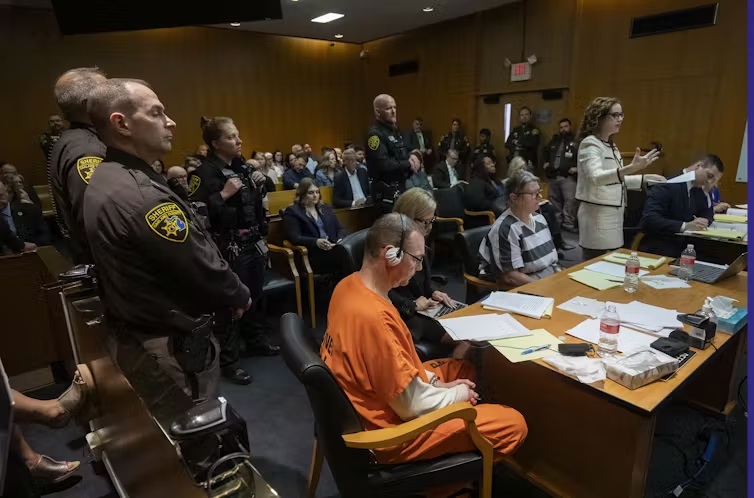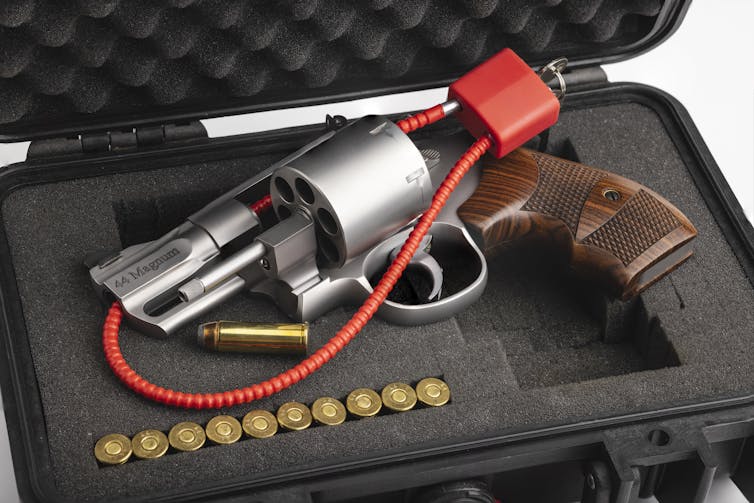What parents in Michigan – and everywhere – should know about safe gun storage after the Crumbley convictions

by Justin Heinze, University of Michigan; April M. Zeoli, University of Michiganand Frank E. Vandervort, University of Michigan
During the recent trial of James Crumbley, the father of the Oxford, Michigan school shooter, prosecutor Karen McDonald demonstrated the use of the cable lock that federal law requires sellers to include with the 9mm pistol used in the mass shooting.
Installing the lock took about 10 seconds.
Had Crumbley or his wife, Jennifer Crumbley, used the cable lock, the simple act of locking the gun might have saved four teenage lives, spared seven more from being shot, and prevented the trauma of many more. It might also have prevented their 15-year-old son from becoming a murderer and spending the rest of his life in prison.

iStock / Getty Images
In the end, James and Jennifer Crumbley were both sentenced to prison for manslaughter because their actions gave their son access to the gun he used to kill his classmates.
We are public health and law professors researching how to reduce gun violence in American homes, schools, and communities. We are currently collecting data on how well common methods—from social emotional learning and behavioral threat assessment to metal detectors and security cameras—work to make school buildings safe.
Some commentators have welcomed the Crumbley rulings, saying they encourage parents to be more cautious, while others wonder whether the outcome heralds a new wave of convictions of parents.
We expect the results to be rather modest for the following reasons:
Parents have a duty to protect
While the ruling underscores the importance of restricting children’s access to firearms to ensure community safety, parental responsibility is nothing new.
In the United States, laws and court decisions have long established a duty on parents to protect others from harm that their children may cause. This duty includes ensuring that children do not have access to firearms.
This responsibility extends both to civil damages suffered by a child and to his or her criminal acts, which may involve damage to property or personal injury.
Historically, these parental responsibility laws have contained prohibitions against inducing minors to commit crimes and have been part of state criminal codes since the early 20th century.
The most recent wave of laws were introduced in the 1980s and 1990s in response to a rise in gun violence among young people, fueled in large part by youth access to firearms during the crack epidemic.

The Crumbley parents’ cases fit into this legal tradition. What is unique, however, is that they were charged with more serious and serious crimes. Why? Probably because of the unusual and, one hopes, entirely unique circumstances of the case.
Young people’s access to weapons begins at home
Although school safety advocates are celebrating a hard-fought decline in bullying, fighting and even weapons being brought to school, the frequency and severity of school shootings have increased over the past decade.
It is estimated that over 80% of the guns used in school shootings come from the home of the perpetrator’s parents or relatives. Children are aware of the guns in their homes and can access them more easily than their parents realize.
The sad truth is that while safety is the most common reason Americans cite for keeping a firearm in the home, without proper precautions, firearms can pose one of the greatest dangers to children.
When it comes to serious injuries and deaths among children and young people, firearms are more dangerous than cars, kidnappings, drugs or disease – all the dangers that worry us parents so much.
Secure storage options can make the home safer for children without restricting access to firearms for self-defense. In addition to cable locks, trigger locks, gun safes, lock boxes, and disassembling firearms are other simple and inexpensive ways to prevent accidental access by children.
Due in part to the Oxford High School shooting, the state of Michigan passed a law in 2023 requiring individuals to keep firearms inaccessible to children.
Under this new law, adults can be charged with a misdemeanor if a child gains access to a firearm that they have improperly stored. However, if the child injures or kills someone with the firearm, adults can be charged with a felony that can result in jail time. Importantly, this law applies to all households, including those where children do not live but are just visiting.
Michigan’s law is not the only one taking this approach. Currently, 26 states and Washington DC have laws requiring the safe storage of firearms and criminal penalties for non-compliance.
These laws are designed to promote responsible firearm use, including protecting children from firearms. In Michigan, lawmakers expressed hope that the law will encourage more responsible behavior.
Safe storage prevents damage
The rulings in Crumbley’s case could lay the groundwork for how other parents who fail to safely secure their firearms could be charged if their child commits a shooting. In at least two other recent cases, parents have been criminally charged for giving their child access to a firearm used in a shooting.
However, this is unlikely to become the norm. In each of these cases, the facts were extreme. The parents either did nothing to prevent access to a gun or they actually helped the child get the gun.
Fear of a fine or jail time is also probably not the main reason for parents’ behavior. Ultimately, most parents want to protect their children and others. It is possible to find a solution that works for families – safely storing a firearm is quick, easy and inexpensive.
Think about it: 10 seconds could make all the difference.
Justin Heinze, Associate Professor of Health Behavior and Health Education, University of Michigan; April M. Zeoli, Associate Professor of Public Health, University of Michiganand Frank E. Vandervort, Clinical Professor of Law, University of Michigan
This article is republished from The Conversation under a Creative Commons license. Read the original article.


